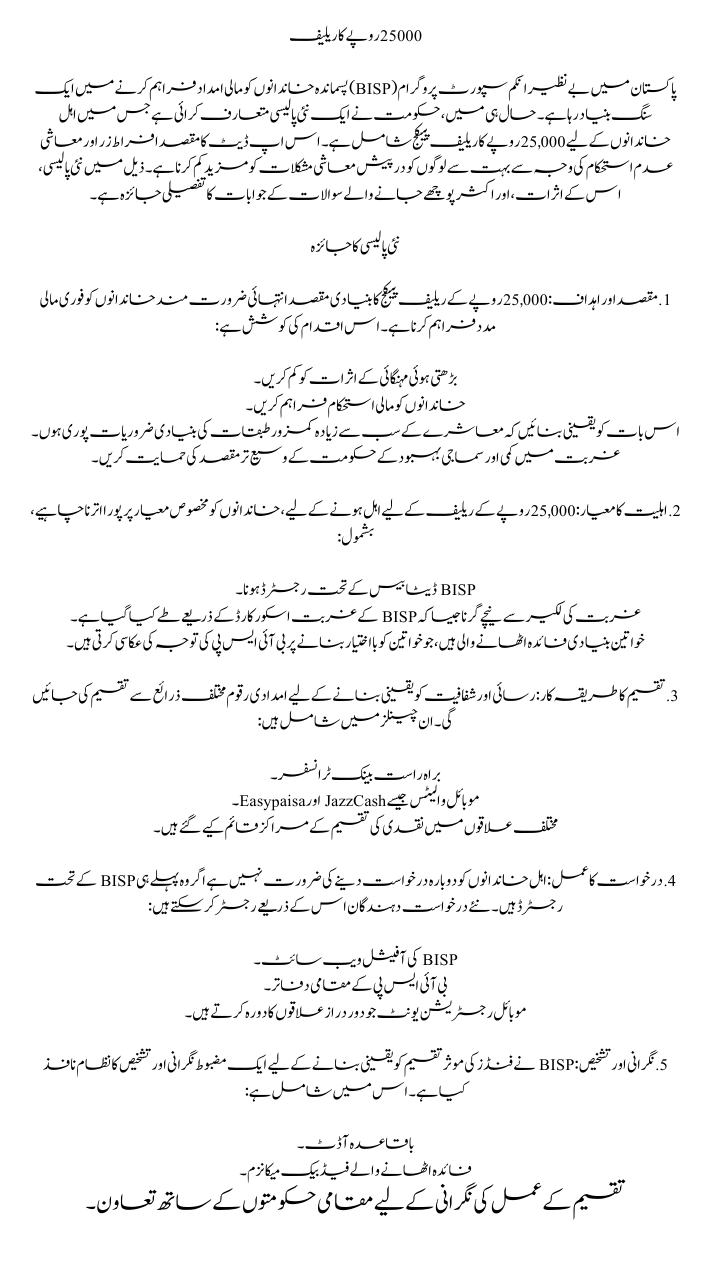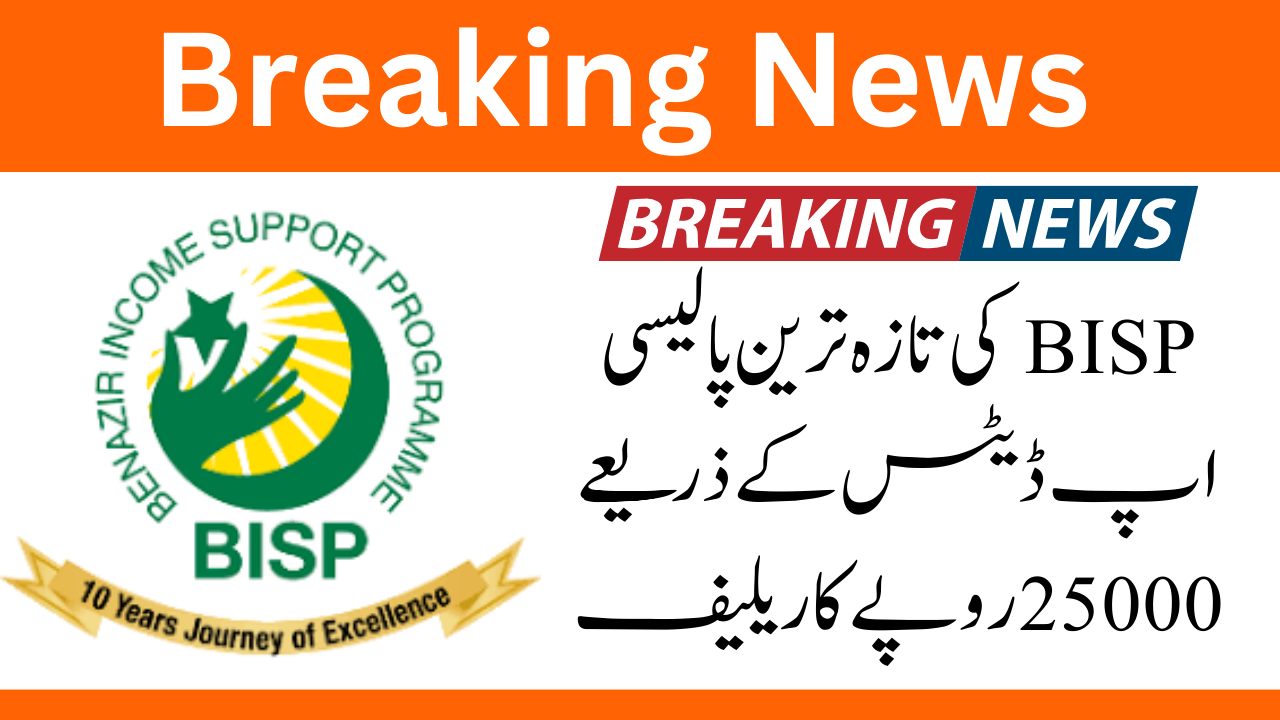25000 Rupees Relief
The Benazir Income Support Programme (BISP) in Pakistan has been a cornerstone in providing financial assistance to underprivileged families. Recently, the government has introduced a new policy that includes a relief package of 25,000 Rupees for eligible families. This update aims to further alleviate the economic hardships faced by many due to inflation and economic instability. Below is a detailed overview of the new policy, its implications, and answers to frequently asked questions.
Overview of the New Policy
1. Purpose and Goals: The primary aim of the 25,000 Rupees relief package is to provide immediate financial support to families in dire need. This initiative seeks to:
- Mitigate the effects of rising inflation.
- Provide financial stability to families.
- Ensure basic needs are met for the most vulnerable segments of society.
- Support the government’s broader goal of poverty reduction and social welfare.
2. Eligibility Criteria: To qualify for the 25,000 Rupees relief, families must meet specific criteria, including:
- Being registered under the BISP database.
- Falling below the poverty line as determined by the BISP’s Poverty Scorecard.
- Women being the primary beneficiaries, reflecting BISP’s focus on empowering women.
3. Distribution Mechanism: The relief funds will be distributed through various channels to ensure accessibility and transparency. These channels include:
- Direct bank transfers.
- Mobile wallets such as JazzCash and Easypaisa.
- Cash disbursement centers established in different regions.
4. Application Process: Eligible families do not need to reapply if they are already registered under the BISP. New applicants can register through:
- The BISP official website.
- Local BISP offices.
- Mobile registration units that visit remote areas.
5. Monitoring and Evaluation: The BISP has implemented a robust monitoring and evaluation system to ensure the effective distribution of funds. This includes:
- Regular audits.
- Beneficiary feedback mechanisms.
- Collaboration with local governments to oversee the distribution process.

Frequently Asked Questions (FAQs)
Q1: What is the Benazir Income Support Programme (BISP)?
A1: BISP is a social safety net initiative by the government of Pakistan, aimed at providing financial assistance to low-income families. It focuses on alleviating poverty and empowering women through direct cash transfers and other welfare programs.
Q2: Who is eligible for the 25,000 Rupees relief package?
A2: Families registered under the BISP and falling below the poverty line as per the BISP’s Poverty Scorecard are eligible. The primary beneficiaries are women from these families.
Q3: How can I check my eligibility for the 25,000 Rupees relief?
A3: You can check your eligibility by:
- Visiting the official BISP website and entering your CNIC number.
- Sending an SMS to the BISP helpline with your CNIC number.
- Visiting your local BISP office for assistance.
Q4: How will the 25,000 Rupees be distributed?
A4: The relief funds will be distributed through:
- Direct bank transfers to the beneficiary’s account.
- Mobile wallets such as JazzCash and Easypaisa.
- Cash disbursement centers for those without bank accounts or mobile wallets.
Q5: Do I need to apply for the relief package if I am already a BISP beneficiary?
A5: No, existing BISP beneficiaries do not need to reapply. The relief package will be automatically provided to eligible families based on the BISP database.
Q6: How can new applicants register for the BISP?
A6: New applicants can register by:
- Visiting the BISP official website and filling out the registration form.
- Going to their local BISP office with the necessary documentation.
- Utilizing mobile registration units in their area.
Q7: What documents are required for new registration?
A7: The required documents typically include:
- CNIC of the applicant.
- Proof of income or poverty status.
- Utility bills or other documents verifying residence.
Q8: How does the BISP determine the poverty status of a family?
A8: The BISP uses a Poverty Scorecard, which assesses various factors such as income, household size, education level, and employment status to determine a family’s poverty status.
Q9: Can I receive the relief package through multiple channels?
A9: No, each family will receive the relief package through a single channel. You can choose the most convenient method for you, whether it’s a bank transfer, mobile wallet, or cash disbursement center.
Q10: What should I do if I face issues with receiving the relief funds?
A10: If you encounter any issues, you should:
- Contact the BISP helpline immediately.
- Visit your local BISP office for assistance.
- Report the issue through the BISP official website.
Q11: Are there any fees or charges for receiving the relief funds?
A11: No, there are no fees or charges for receiving the relief funds. The full amount of 25,000 Rupees will be provided to the beneficiary.
Q12: How can I provide feedback or file a complaint about the BISP services?
A12: You can provide feedback or file a complaint by:
- Calling the BISP helpline.
- Using the feedback form on the BISP official website.
- Visiting your local BISP office and speaking with a representative.
Q13: How frequently will the 25,000 Rupees relief be provided?
A13: The 25,000 Rupees relief is a one-time assistance package aimed at providing immediate financial support. Additional assistance will be based on further government policies and announcements.
Q14: What measures are in place to prevent fraud in the distribution of relief funds?
A14: The BISP has implemented several measures to prevent fraud, including:
- Regular audits and inspections.
- Beneficiary verification processes.
- Collaboration with local authorities to monitor the distribution.
Q15: Can I receive the relief package if I am already receiving other government assistance?
A15: Yes, you can receive the 25,000 Rupees relief package in addition to other government assistance, provided you meet the eligibility criteria set by the BISP.
Q16: Will receiving the relief package affect my eligibility for other BISP programs?
A16: No, receiving the relief package will not affect your eligibility for other BISP programs. It is designed to provide additional support without impacting your participation in other initiatives.
Q17: How can I update my information in the BISP database?
A17: You can update your information by:
- Visiting your local BISP office with the relevant documents.
- Using the online portal on the BISP website to make changes.
- Contacting the BISP helpline for guidance on the update process.
Q18: What should I do if my relief funds are delayed or not received?
A18: If your relief funds are delayed or not received, you should:
- Contact the BISP helpline immediately.
- Visit your local BISP office to report the issue.
- Use the complaint form on the BISP official website.
Q19: Are there any plans to increase the relief amount in the future?
A19: The government periodically reviews and adjusts the relief amounts based on economic conditions and feedback from beneficiaries. Any updates will be communicated through official channels.
Q20: How can I stay updated with the latest BISP announcements and policies?
A20: You can stay updated by:
- Regularly visiting the BISP official website.
- Following BISP’s official social media channels.
- Subscribing to the BISP newsletter for email updates.
- Visiting your local BISP office for the latest information.
Conclusion
The introduction of the 25,000 Rupees relief package by the BISP is a significant step towards providing immediate financial support to underprivileged families in Pakistan. By addressing the pressing needs of the most vulnerable segments of society, this initiative aims to alleviate economic hardships and promote social welfare. For further information and assistance, beneficiaries are encouraged to utilize the various support channels provided by the BISP.
